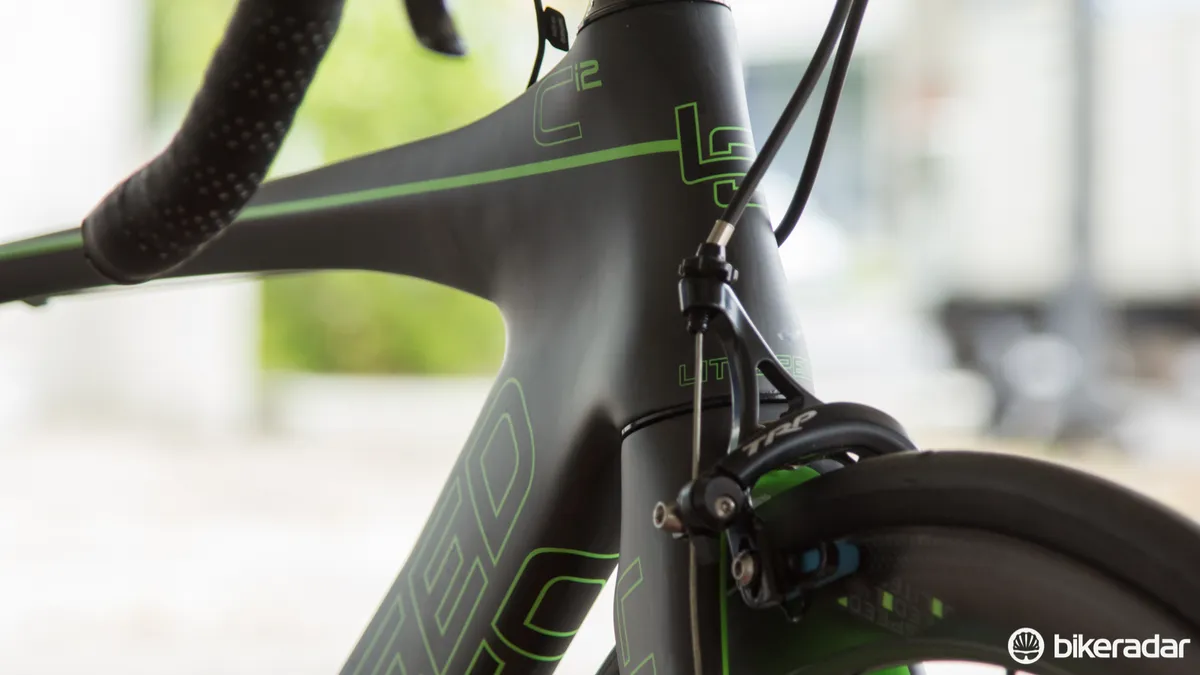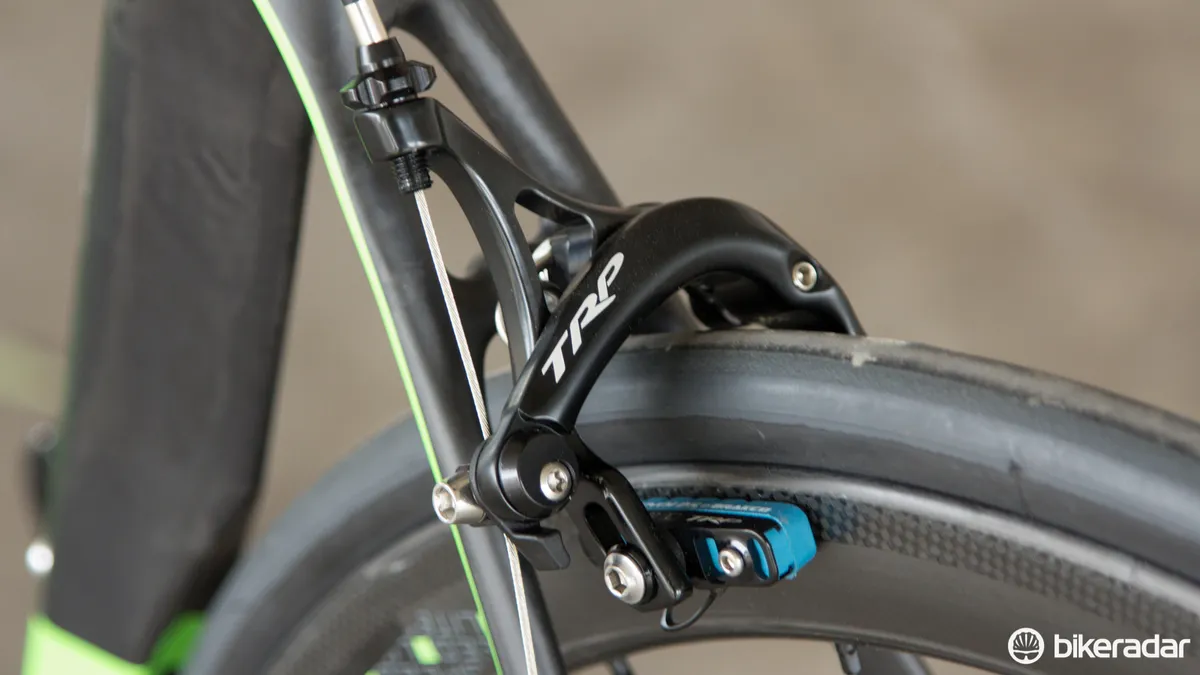When you think of Tennessee based Litespeed Bicycles, carbon is not the frame material that comes to mind. Indeed, with Litespeed's pedigree in titanium, we were borderline dubious when the carbon Ci2 aero bike rolled through our door.
Striking the right balance between wind tunnel numbers, real world riding scenarios and ride quality is something we have seen many brands boast, only for them to stumble when it comes to the crunch of testing. Billed as a full blown aero road race bike, the C-series is the result of three years of wind tunnel testing, and comes with a claimed 16 percent advantage at all yaw angles, in addition to claims of superior ride quality.
Ride and handling: fast, controlled and surefooted
Just about everything on the Ci2 is designed to improve aerodynamics, resulting in tubing that appears more equipped for competition in the Americas Cup, rather than in your local crit. Despite the massive tube profiles, the Ci2 is remarkably unaffected by cross winds. Even with the 41mm Reynolds Assault carbon clinchers, the bike retains its manners in off-angle gusts – arguably better than some round tubed steeds.
Often frames that feature tubing designed to cheat the wind (especially aero seat tubes) suffer from harsh ride characteristics. While the Ci2 is no plush La-Z-Boy, it also didn’t leave us feeling beaten and battered the way other aero frames have in the past. Partial credit must be given to the 23c Vittoria Rubino Pro Slicks for aiding in comfort.

Litespeed claims the bowed fork adds an aerodynamic advantage; we found it vastly stiffened the front endWith such a wide strung fork and stiff front triangle, handling is quick and accurate. The trade-off to this frontal stiffness is a little less compliance than that felt out back. On fast descents the Ci2 has a controlled and surefooted behavior – only the roughest of corners shows that the front wheel is slightly less planted than the rear. Where the front end and bottom bracket junction are seemingly immune to twisting, seated efforts reveal minor lateral flex at the seat tube.
While we didn’t log any wind tunnel time aboard the Ci2, we can say we spent a surprising amount of time in the 12-tooth cog (there is no 11) at the back. The Litespeed cuts through the air, definitely assisted by the Assault carbon clinchers, which spin up quickly and hold speed well.

The hourglass head tube has a long trailing edge to smooth turbulent air
Frame: carbon wizardry
While Litespeed’s expertise in titanium frames is renowned, the firm is apparently also pretty clever when it comes to carbon – Toray T30 carbon, in this case. The American brand makes a bunch of lofty claims about how it's aerodynamically tuned the tubing to not only slice through the air, but also to stabilize the bike, as well as the wide ‘bowed’ fork to reduce air turbulence in addition to softening the ride (that last part we didn't experience).
It's always tempting to dismiss such statements as simply marketing jargon, but when it comes to the Ci2 such rants feel a little unjustified. Litespeed has obviously done its homework, and the combination of aero performance and comfort we experienced ranks the bike among the best of aero road frames.

Saying the bottom bracket shell is massive would be an understatementIt's not all good news though. While most brands now manage to offer convertible cable ports to support both mechanical and electronic drivetrains, the Litespeed does not – locking you into a system. The Ci2 (as the name implies) is the electronic specific version of the frame – the C1 is identical to the Ci2, barring the Ultegra mechanical gears and paintjob. Sitting behind the steerer is the port where the shift wire enters the slender top tube.
Despite the internal Di2 routing, and aerodynamic claims made by Litespeed, the rear brake is externally routed. While this makes replacing the cables and housing convenient, it seems like somewhat of an afterthought. Whether less aerodynamic or not, it spoils the otherwise clean aesthetic.

An externally routed rear brake cable is a questionable choiceMore pleasingly, it's good to see – with wider rubber becoming a standard race spec – that the scooped frame is capable of accommodating 25c (tested with Continental Grand Sport) with a little wiggle room for grit and mud.
Our size medium sample features race ready geometry – a 54cm top tube, 73 degree head angle, 130mm head tube – and tipped the scales at a respectable 7.46kg.
Equipment: money well directed
Sitting mid-range in the C-series, the Ci2, barring a few cost saving measures, is remarkably well equipped for the price.
Being built for speed, it’s no surprise to see the Ci2 with full size 53/39t chainrings out front, and 12-25t at the rear. Given our climber physiques, we didn’t miss the 11t and found the 12t well-suited to long and flat straight runs. Other riders may wish for a wider spread ratio cassette.
The TRP brakes on our sample performed well, but the single bolt calipers just don't provide the same power and modulation as their Shimano counterparts. Reynolds Cryo-Blue brake pads offered consistent braking in dry conditions and decent stopping power in the wet. Thankfully, the 2015 version of this bike will be moving to Shimano Ultegra calipers.

While it appears to be a tight squeeze the seatpost cutout is scalloped in the middle, easily accommodating beefy 25c Continental Grandsport rubberIt's a similar story at the crankset – the FSA SL-K Light doesn’t shift quite as fast as a Shimano counterpart, though the stiff carbon crank arms do well on the scale. In combination with the massive BB30 bottom bracket shell, it provides an unyielding pedaling platform.
Both the FSA crank and TRP brakes are present to cut overall cost, but the money saved on these components – which perform well enough – is well spent in other areas of the build.

The Easton cockpit is stiff but doesn’t add much comfort to the front endLitespeed has put that money toward a race ready set of 41mm Reynolds Assault carbon clinchers. The hoops add to the slippery nature of the Ci2, but are stiff and sprightly enough for quick attacks on climbs. In crosswinds the Assaults are remarkably well behaved – gusts caused some side pressure, but it was gradual and predictable.
Ultegra Di2 drivetrains are becoming an ever-popular choice for those looking for top level performance at a less eye-popping price tag. Both front and rear shifting is fast and flawless, but our 2014 sample frame features the older external battery. For 2015, the Australian distributor has assured us, the Ci2 will have the internal race battery.

While most current frames accept both mechanical and electronic drivetrains, the Ci2 is only compatible with the latter
Up front, Easton's alloy EA-70 bars and stem are quite stiff, but do little for the front-end comfort. For those who appreciate a flat saddle, the Fizik Arione R7 will delight, though we found the cover on this specific model a tad slippery.
Given just how much we were impressed with this bike, it's almost surprising to know that there is a frame model above this – the C1R – using a higher modulus carbon (60T). With this not being the flagship, it sits at a very well priced US$5000/AU$4,999 (UK price TBC).
Note: In Australia, Litespeeds are a rare breed, with a direct to consumer business model through Sydney-based Pedals Plus. This means the Ci2 provides amazing value for money and is well worth the search.








